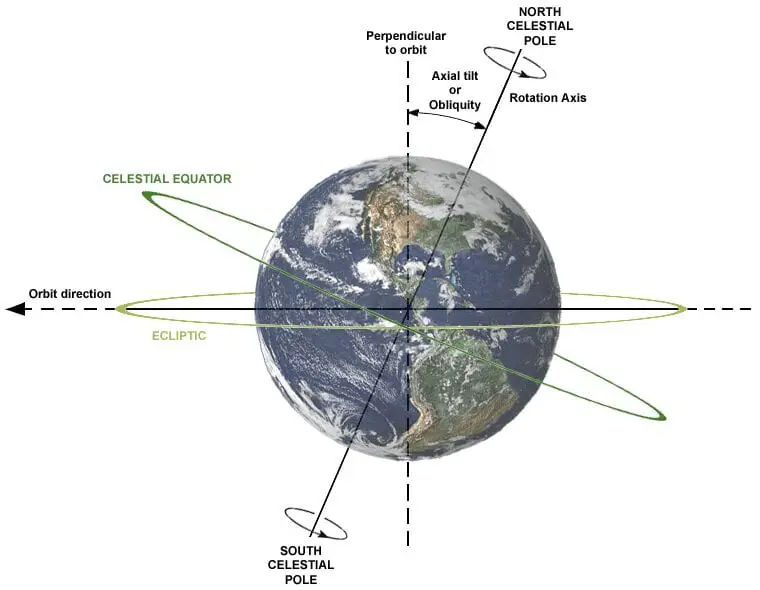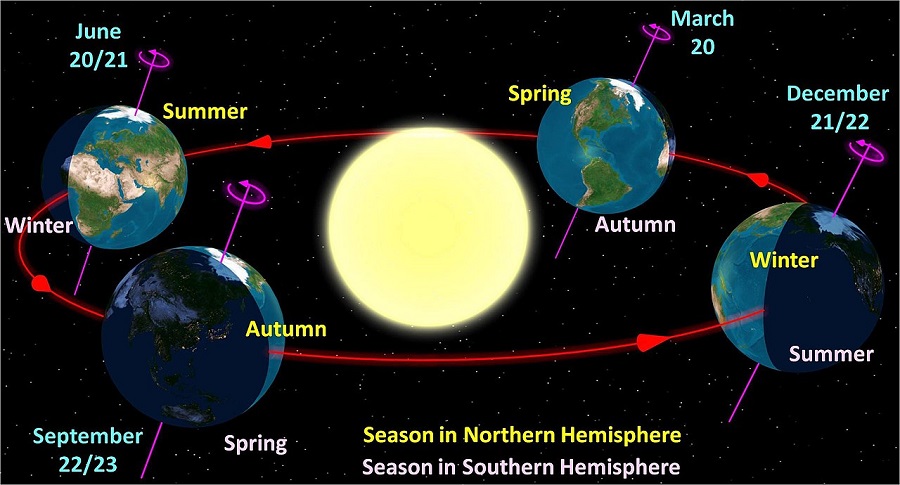The Equator divides the Earth into northern and southern hemispheres. Therefore, as a result, if you are living in places below the equator i.e in the southern hemisphere, you get to see totally different seasons as compared to the places above the equator i.e in the northern hemisphere. In other words, seasons in the southern hemisphere are opposite to the seasons in the northern hemisphere.
For example, when there is a summer season in the southern hemisphere, at the same time, there is a winter season in the northern hemisphere. Just to mention, I am only going to explain seasons in the southern hemisphere. However, you can check this article to know more about the seasons in the northern hemisphere and their bizarre consequences.
So, the question of this hour is how many seasons are there in the southern hemisphere? I mean, do we have four seasons, or do we have six seasons? Additionally, when do these seasons occur, or do their date changes every year? Most importantly, why do we observe seasons in the first place? Well, if you wanna get a detailed insight, I will suggest you stick with me till the end. Let’s dive right in…!!!
Why do we have seasons?
Just because the earth has an axial tilt of 23.4 degrees, we are able to observe different seasons. In fact, the earth’s tilt is also responsible for the seasonal mismatch between the northern and the southern hemisphere. So, here is my question for you…!!! What if there was no axial tilt?

Well, if there was no axial tilt, there won’t be any season on the earth’s surface. In fact, this formula is also applicable to all of the planets in our solar system. For example, Mercury doesn’t have any axial tilt. Therefore, as a result, it does not have any seasons.
On the other hand, Neptune has an axial tilt of 28.5 degrees. Therefore, as a result, Neptune does have noticeable seasonal changes. With this, we can move on to our next question…!!!
How many seasons are there?
Frankly speaking, different cultures have different ways to define that how many seasons are there. For example, as per Indians, (I am an Indian), we have 6 seasons in a calendar year. Since a calendar year has 12 months, therefore, we allot two months to each season.
These are Late Winter (mid-Jan to mid-March), Spring (mid-March to mid-May), Summer (mid-May to mid-July), Monsoon (mid-July to mid-September), Autumn (mid-Sept to mid-Nov), and, Early Winter (mid-Nov to mid-Jan).
However, if we talk about some common ground, as per fundamentally accepted seasons, we have only four seasons in a calendar year. Again, since a calendar year has 12 months, therefore, each season lasts about three months. These are Spring, Summer, Autumn, and Winter.
Definition of Seasons
There are two ways to define seasons. These are the astronomical and meteorological definitions of seasons. As per astronomy, the arrival of equinoxes and solstices marks the beginning as well as the end of the seasons in the southern hemisphere.
For example, not only June Solstice marks the official arrival of the first day of winter in the southern hemisphere. But also marks the end of the fall in the southern hemisphere.
On the other hand, in meteorology, equinoxes and solstices are not considered for the seasonal definition. As per meteorological definitions, seasons start on the first day of the month. For example, the Winter season in the southern hemisphere starts on June 1 and stays till August 31.
Editor’s Choice: Equinox vs Solstice – What’s the Difference?
Different Seasons in Southern Hemisphere

There are four seasons that occur in the earth’s southern areas. Autumn occurs in the month of March. Then, winters in June, then, spring in September, and then, finally summers in December.
Not to mention, their start and end date change as per their astronomical and meteorological definitions. Let us get to know each one of them in detail. But before going ahead, take a look at the table given below.
Seasons in Southern Hemisphere
| Seasons | Meteorological Season Dates | Astronomical Season Dates |
| Autumn Equinox | Friday, 1 March 2024 | Tuesday, 20 March 2024 |
| Winter Solstice | Saturday, 1 June 2024 | Friday, 21 June 2024 |
| Spring Equinox | Sunday, 1 September 2024 | Sunday, 22 September 2024 |
| Summer Solstice | Sunday, 1 December 2024 | Saturday, 21 December 2024 |
Fall in Southern Hemisphere

Fall in southern hemisphere comes in month of March. On this day, sun crosses over imaginary celestial line from south to north direction. As a result, earth’s southern areas start to cool down rapidly. Hence, marking the end of the summer and the arrival of the first day of fall in the southern hemisphere.
Additionally, on the eve of March Equinox, daylight and nighttime hours become equal. And, after that, days will become shorter and shorter with each passing day. For the people of the southern hemisphere, this process of shorter days and longer nights will go on until the arrival of the June solstice which marks the end of the fall and the arrival of winters in Earth’s southern areas.
When does autumn/fall start in the southern hemisphere?
As per meteorological definition, the fall starts on March 1 and stays till May 31. However, as per astronomical definition, the first day of fall occurs on the eve of March Equinox. In 2024, March Equinox i.e first day of fall in southern hemisphere will occur on Tuesday, March 20, at sharp 02:07 PM Australian Eastern Daylight Time (AEDT).
Winter in Southern Hemisphere

Winter in southern hemisphere comes in month of June. On this day, south pole of earth is at its maximum tilt away from sun. Hence, earth’s southern areas receive minimum sunlight, marking the darkest as well as the shortest day of the year in the southern hemisphere.
Additionally, on the eve of June Solstice, for the southerners, not only the sun’s orbital path across the sky will be as low as it can, but the sun will also enter the tropic of cancer on the eve of the June solstice.
When does winter start in the southern hemisphere?
As per meteorological definition, the winter starts on June 1 and stays till August 31. However, as per astronomical definition, the first day of winter occurs on the eve of the June Solstice. In 2024, June Solstice i.e first day of winter in southern hemisphere will occur on Friday, June 21, at sharp 06:51 AM Australian Eastern Standard Time (AEST).
Spring in Southern Hemisphere

Spring in southern hemisphere comes in the month of September. On this day, the sun crosses over the imaginary celestial line from the north to the south direction. Therefore, as a result, the earth’s southern areas start to warm up rapidly. Hence, marks the end of winter and the arrival of the first day of spring in the southern hemisphere.
Additionally, daylight and nighttime hours become equal on the eve of September Equinox. And, after that, days will become longer and longer with each passing day. For the people of the southern hemisphere, this process of longer days and shorter nights will go on until the arrival of the December solstice that marks the arrival of the Summer season in Earth’s southern areas.
When does spring start in the southern hemisphere?
As per meteorological definition, the spring starts on September 1 and stays till November 30. However, as per astronomical definition, the first day of spring occurs on the eve of September Equinox. In 2024, September Equinox i.e first day of spring in southern hemisphere will occur on Sunday, September 22, at sharp 10:44 PM Australian Eastern Standard Time (AEST).
Editor’s Choice: Full Worm Moon – Last Full Moon before Spring in Southern Hemisphere
Summer in Southern Hemisphere

Summer in southern hemisphere comes in the month of December. On this day, south pole of earth is at its maximum tilt towards the sun. Hence, earth’s southern areas receive maximum sunlight, marking the brightest as well as the longest day of the year in the southern hemisphere.
Additionally, on the eve of the December solstice, for the southerners, not only the sun’s orbital path across the sky will be as high as it can, but the sun also enters the tropic of Capricorn on the eve of the December solstice.
When does Summer start in the southern hemisphere?
As per meteorological definition, the summer starts on December 1 and stays till February 28 (February 29 in a Leap Year). However, as per astronomical definition, the first day of summer occurs on the eve of the December Solstice. In 2024, the December solstice i.e first day of summer in southern hemisphere will occur on Saturday, December 21, at sharp 08:20 PM Australian Eastern Daylight Time (AEDT).
That’s it for this post. If you like this article, share it if you like, like it if you share it. You can also find us on Mix, Twitter, Pinterest, and Facebook. Hey man, If you have come this far, do give us feedback in the comment section. It would make my day. You can also make a donation. Your donations will help us to run our website and serve you BETTER. Cheers!!!
You might also like:
- March Equinox 2024 – First Day of Spring in Northern Hemisphere
- June Solstice 2024 – First Day of Summer in Northern Hemisphere
- September Equinox 2024 – First Day of Fall in Northern Hemisphere
- December Solstice 2024 – First Day of Winter in Northern Hemisphere

Nice
Very informative, thanks 🙏
Is Winter in southern hemisphere colder or warmer than northern hemi?
Around 80% of the southern hemisphere is ocean and as per the available data, water conducts and retains heat better than land, hence, winter in southern hemisphere is a bit warmer than than northern hemishpere.